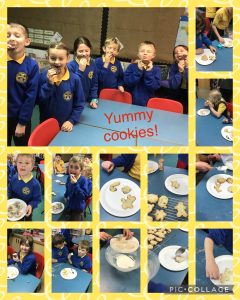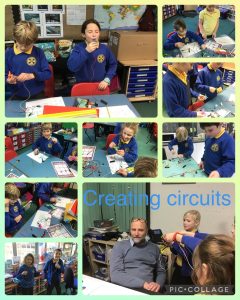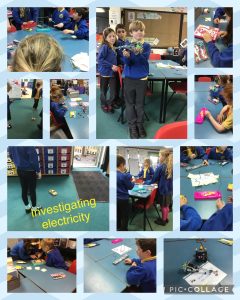Science
We have started a new unit all about electricity. In our first lesson we had to look at different toys that use electricity and figure out how they worked. We were allowed to play with the wire buzzer games to see what made it work. We discovered that when the wire hook touched against the wire shape that a circuit was completed and closed. We then realised that we could make a human circuit and make the buzzer game work! We also looked at ‘operation’ style games as well as remote control cars and model helicopters. We all learnt that each of these games has some sort of electric circuit that needs to be closed in order for the toy/game to work.
After this lesson we then looked at what a circuit needs in order for it to work and what would stop it from doing so. We were given a lot of electrical equipment and had to predict whether or not the circuit was complete. If it wasn’t, we had to figure out how to fix it so that it lit the bulb or moved the motor. Some of us worked out how to make more than one fan,bulb and buzzer work at the same time. It is a lot of fun learning about electricity and we are looking forward to doing more circuit experiments.
English – The Clocktower
We have learnt a retell version of this animation:
After learning the retell, we mapped out the story in our books and had to memorise each section to help us with our writing. We have planned our own wishing tales using a box up sheet and are now starting to write our own versions of the tale. Some of us are putting in a few extra twists to surprise the reader. Miss Tonner was very pleased with how well we did with the start of our stories; let’s hope we can do the same with the next parts!
Maths – Column methods
This term we have begun working on written methods for adding and subtraction. We have to make sure that we line up the digits in the correct column so that when we add or subtract we are focusing on the correct digit. We must always start with the ones column and work our way through the tens, hundred and then thousands. Sometimes when you are adding, you might have to regroup (some people call this carrying) ones or tens etc. When you are subtracting, you may need to exchange a ten or hundred so that you can subtract effectively in the correct column. We are really enjoying learning these methods and are feeling confident with them.
Baking cookies
In the last week of autumn term we were supposed to bake cookies, but due to the snow day, our plans were altered so Miss Tonner let us bake cookies when we came back after the Christmas holidays. We worked in groups to make the cookies and after they had baked and cooled down, we could decorate them with icing and sprinkles. They were delicious; some of us ate them all while others took a few home to share. We hope we can do more baking this year.
Geography – Rivers
This term we are learning about rivers. We have learnt the journey of a river and all of the keywords linked to this. We had to draw this out and show where all of the features of a river are. Have you ever heard of an ox-bow lake? What about a tributary? Each week Miss Tonner tests us on which words we can remember and which ones we can explain. We have started mapping out where the rivers of the U.K. are and will then be looking at a river of our choice to research. We know of 4 rivers that have a link to Gloucestershire – they flow through it or start in it: Severn, Thames, Avon and Wye. We also learnt that the River Nile in Egypt is the longest river in the world!
Art
We are looking at a British artist called Stephen Wiltshire who creates works of art focusing on cityscapes. He uses pens and pencils to draw locations like London, Paris, New York and so many other cities across the world. What is amazing about Stephen is that he can memorise any cityscape and then draw it. He is known as the human camera and has been drawing since he was a child. He was diagnosed with autism at a very young age; he couldn’t talk until he was around 5-6 years old, so he would communicate through his drawings. It is said that some of his first words were paper and pencil. He had his work published in books before having it displayed all over the world. Some of his works can take up to 6 days to complete. In the next few weeks we are going to see if we can look at a building and then draw it from memory just like he does. 





